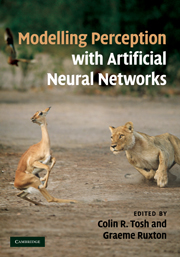Book contents
- Frontmatter
- Contents
- Contributors
- Introduction: Modelling perception with artificial neural networks
- Part I General themes
- Part II The use of artificial neural networks to elucidate the nature of perceptual processes in animals
- 3 Correlation versus gradient type motion detectors: the pros and cons
- 4 Spatial constancy and the brain: insights from neural networks
- 5 The interplay of Pavlovian and instrumental processes in devaluation experiments: a computational embodied neuroscience model tested with a simulated rat
- 6 Evolution, (sequential) learning and generalisation in modular and nonmodular visual neural networks
- 7 Effects of network structure on associative memory
- 8 Neural networks and neuro-oncology: the complex interplay between brain tumour, epilepsy and cognition
- Part III Artificial neural networks as models of perceptual processing in ecology and evolutionary biology
- Part IV Methodological issues in the use of simple feedforward networks
- Index
- References
6 - Evolution, (sequential) learning and generalisation in modular and nonmodular visual neural networks
from Part II - The use of artificial neural networks to elucidate the nature of perceptual processes in animals
Published online by Cambridge University Press: 05 July 2011
- Frontmatter
- Contents
- Contributors
- Introduction: Modelling perception with artificial neural networks
- Part I General themes
- Part II The use of artificial neural networks to elucidate the nature of perceptual processes in animals
- 3 Correlation versus gradient type motion detectors: the pros and cons
- 4 Spatial constancy and the brain: insights from neural networks
- 5 The interplay of Pavlovian and instrumental processes in devaluation experiments: a computational embodied neuroscience model tested with a simulated rat
- 6 Evolution, (sequential) learning and generalisation in modular and nonmodular visual neural networks
- 7 Effects of network structure on associative memory
- 8 Neural networks and neuro-oncology: the complex interplay between brain tumour, epilepsy and cognition
- Part III Artificial neural networks as models of perceptual processing in ecology and evolutionary biology
- Part IV Methodological issues in the use of simple feedforward networks
- Index
- References
Summary
Introduction
In general terms, modular systems are systems that can be decomposed in functional and/or structural independent parts. In cognitive science, modularity of mind (Fodor, 1983) is the controversial cognitivist view according to which human mind is made up of specialised innate modules. In contrast, the connectionist view tends to conceive of mind as a more homogeneous system that results from development and learning during life (see Karmiloff-Smith, 2000).
What is a module? Are modules innate? What is the relationship between modularity, robustness and evolvability? And what is the role of nonmodularity? These are only a few of the open central questions in the nature–nurture debate.
In a paper published in the journal Cognition, Gary Marcus (2006) deals with the vexata quaestio of modularity of mind from an enlightening point of view. He does not offer a detailed definition of modularity, nor an answer to the controversial issue of what is innate and what is learned during life. More simply, he identifies and contrasts two competing ‘hypothetical conceptions of modularity’, which would represent distinct perspectives about modularity of mind, implicitly present in the scientific literature and different in their implications: a ‘sui generis modularity’ and a ‘descent with modification modularity’. According to the former conception, ‘each cognitive (or neural) domain would be an entity entirely unto itself’; according to the latter conception, ‘current cognitive (or neural) modules are to be understood as being the product of evolutionary changes from ancestral cognitive (or neural) modules’.
Information
- Type
- Chapter
- Information
- Modelling Perception with Artificial Neural Networks , pp. 114 - 133Publisher: Cambridge University PressPrint publication year: 2010
